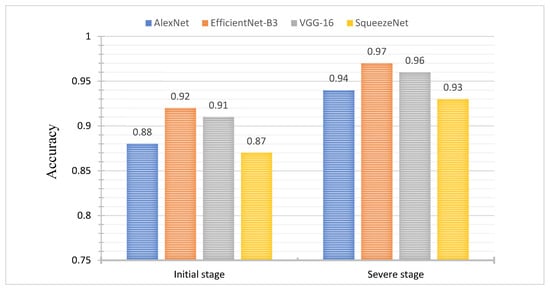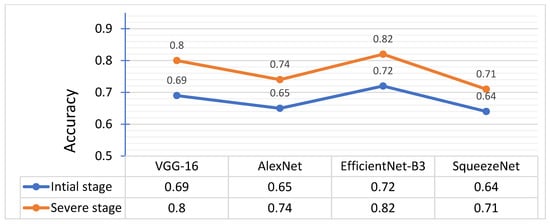Plant health is the basis of agricultural development. Plant diseases are a major factor for crop losses in agriculture. Plant diseases are difficult to diagnose correctly, and the manual disease diagnosis process is time consuming. For this reason, it is highly desirable to automatically identify the diseases in strawberry plants to prevent loss of crop quality. Deep learning (DL) has recently gained popularity in image classification and identification due to its high accuracy and fast learning. In this research, deep learning models were used to identify the leaf scorch disease in strawberry plants. Four convolutional neural networks (SqueezeNet, EfficientNet-B3, VGG-16 and AlexNet) CNN models were trained and tested for the classification of healthy and leaf scorch disease infected plants. The performance accuracy of EfficientNet-B3 and VGG-16 was higher for the initial and severe stage of leaf scorch disease identification as compared to AlexNet and SqueezeNet. It was also observed that the severe disease (leaf scorch) stage was correctly classified more often than the initial stage of the disease. All the trained CNN models were integrated with a machine vision system for real-time image acquisition under two different lighting situations (natural and controlled) and identification of leaf scorch disease in strawberry plants. The field experiment results with controlled lightening arrangements, showed that the model EfficientNet-B3 achieved the highest classification accuracy, with 0.80 and 0.86 for initial and severe disease stages, respectively, in real-time. AlexNet achieved slightly lower validation accuracy (0.72, 0.79) in comparison with VGGNet and EfficientNet-B3. Experimental results stated that trained CNN models could be used in conjunction with variable rate agrochemical spraying systems, which will help farmers to reduce agrochemical use, crop input costs and environmental contamination.
1. Introduction
The marks of leaf scorch disease consist of many small irregular purple spots that appear on the outward leaf’s surface. It has a similar disease cycle to other fungal diseases and it is managed in the same way. These diseases can cause significant economic damage. Control of strawberry leaf scorch disease is important because it is responsible for losses ranging from negligible to severe in strawberries. Leaf scorch disease affects the yield of the strawberry crop. The application of appropriate fungicides at the early stage of leaf scorch disease can reduce crop production losses. Plant disease and pest control at the early stages of infections is essential for higher agricultural production [1].
2. CNNs Models Performance Results
The CNN models (AlexNet, VGG-16, SqueezeNet, EfficientNet-B3) were trained at an 80:20 dataset splitting ratio (80% dataset used for training, 13% for validation, and 7% for testing). The values of recall, F1-score, and precision obtained from all models on the test dataset are provided in Table 1. For all CNNs models, classification accuracy values were recorded in the range of 0.88 to 0.92 and 0.93 to 0.98 for initial and severe disease stages, respectively. The validation results show that the EfficientNet-B3 outperformed than the other CNN models and achieved higher values of accuracy, precision, sensitivity/recall, and F1-score.
Table 1. CNN models validation results for the classification of disease infected strawberry leaves.
| Model |
Disease Stage |
Precision |
Sensitivity/
Recall |
F1 Score |
Inference Time (ms) |
| VGG-16 |
Initial |
0.91 |
0.90 |
0.90 |
355 |
| Severe |
0.96 |
0.95 |
0.95 |
349 |
| AlexNet |
Initial |
0.88 |
0.89 |
0.88 |
109 |
| Severe |
0.94 |
0.93 |
0.93 |
111 |
| SqueezeNet |
Initial |
0.87 |
0.88 |
0.87 |
76 |
| Severe |
0.93 |
0.92 |
0.92 |
66 |
| EfficientNet-B3 |
Initial |
0.92 |
0.91 |
0.91 |
212 |
| Severe |
0.98 |
0.97 |
0.97 |
222 |
The EfficientNet-B3 model achieved the higher values of precision (0.98), recall (0.97), and F1-score (0.97) for severe disease stage as compared to classification values of initial disease stage infected leaves (precision 0.92, recall 0.91, and F1-score 0.91). The EfficientNet-B3 and VGG-16 significantly performed better than AlexNet for the classification of disease leaves (initial stage and severe stage).
The second-best model was VGG-16, which provided higher values of precision (0.96), recall (0.95), and F1-score (0.95) for the severe disease stage, and the classification accuracy values decrease for initial stage classification. The model recorded values of precision, recall and F1-score were 0.91, 0.90 and 0.90, respectively. SqueezeNet was less effective in the classification of the initial disease stage and attained the lowest values of precision (0.87), recall (0.88), and F1-score (0.87). However, for the classification of severe disease stage, SqueezeNet achieved significant classification values of precision (0.93), recall (0.92), and F1-score (0.92). The validation results show that the SqueezeNet model for the classification of fungal leaf disease recorded lower values of precision, recall and F1-score as compared to the other two models.
The test accuracy is also an effective performance metric used to evaluate the performance of the CNN models. The EfficientNet-B3 model achieved higher accuracy with 0.92 and 0.97 for initial and severe disease stage classification as compared to the VGG-16, AlexNet and SqueezeNet models. The VGG-16 model attained slightly lower accuracy with 0.91 and 0.96 for initial and severe disease stages, respectively, on the other hand SqueezeNet attained the lowermost accuracy values with 0.87 and 0.93 for initial and severe disease stages, respectively (Figure 1). AlexNet also achieved lower classification accuracy in comparison with VGG-16 and EfficientNet-B3. The validation results reveal that overall EfficientNet-B3 model performed better than the other three CNNs models (VGG-16, SqueezeNet, AlexNet) for the classification of both disease stages (initial stage, severe stage).
Figure 1. Accuracy of AlexNet, EfficientNet, VGG-16 and SqueezeNet for the classification of initial and severe stage of leaf scorch disease infected leaves.
CNNs Models Inference Time
The model SqueezeNet recorded that the lowest inference time ranged from 66 to 76 milliseconds as compared to other CNN models. The highest inference time was recorded for the VGG-16 model, which ranged from 349 to 355 milliseconds. There was no significant difference in inference time during initial and severe stage disease infected strawberry leaves. The AlexNet model recorded the second lowest inference time ranging from 212–222 milliseconds.
3. Performance of CNN Models in Real-Time Field Experiments
3.1. Field Experiment with Natural Lighting
The deep learning-based leaf scorch disease classification mobile system was tested in a strawberry field under a natural lightening environment. In natural lighting situations, the direct sunlight was influencing the image acquisition process that causes chromatic color variations and affects the image quality. All four trained CNN models (AlexNet, SqueezeNet, VGG-16, EfficientNet-B3) were implemented in the strawberry fields to identify initial symptoms and severe stages of leaf scorch disease in strawberry plants.
EfficientNet-B3 and VGG-16 performed better than AlexNet and SqueezeNet to correctly identify the infected leaves in real-time during the field experiment (Table 2). The EfficientNet-B3 and VGG-16 models showed significant performances for identifying severe disease stage (leaf scorch) infected leaves and achieved high precision (0.83, 0.80), recall (0.81, 0.78), and F1-score (0.81, 0.78) values. However, for the classification of the initial stage of leaf scorch infected leaves, the values of precision (0.73, 0.70), recall (0.70, 0.67) and F1-score (0.71, 0.68) were considerably lower. SqueezeNet seemed to be unsuccessful at identifying the initial disease stage infected leaves with lower values of precision (0.64), recall (0.61), and F1-score (0.62). However, it showed significant performance for identifying severe disease stage (leaf scorch) infected leaves and achieved better precision (0.73), recall (0.71), and F1-score (0.71) values.
Table 2. CNNs models evaluation results in real-time for the classification of leaf scorch disease.
| Model |
Disease Stage |
Precision |
Sensitivity |
F1 Score |
| VGG-16 |
Initial |
0.70 |
0.67 |
0.68 |
| Severe |
0.80 |
0.78 |
0.78 |
| AlexNet |
Initial |
0.66 |
0.63 |
0.64 |
| Severe |
0.75 |
0.73 |
0.73 |
| SqueezeNet |
Initial |
0.64 |
0.61 |
0.62 |
| Severe |
0.73 |
0.71 |
0.71 |
| EfficientNet-B3 |
Initial |
0.73 |
0.70 |
0.71 |
| Severe |
0.83 |
0.81 |
0.81 |
The EfficientNet-B3 model also achieved higher classification accuracy (0.82) for the severe disease stage, while for initial disease symptoms, the model accuracy was reduced to 0.72. Similarly, the VGG-16 model achieved a higher accuracy of 0.80 for the classification of severe disease stage as compared to initial disease symptoms, with a 0.69 classification accuracy (Figure 2). On the other hand, SqueezeNet gave the lowest accuracy values with 0.64 and 0.71 for initial and severe disease stages, respectively. EfficientNet-B3 and VGG-16 models performed well for the classification of severe stage leaf scorch infected leaves in strawberry plants during the field experiment.
Figure 2. Accuracy of AlexNet, EfficientNet, VGG-16 and SqueezeNet for the classification of initial and severe stage of leaf scorch disease.
3.2. Field Experiment with Controlled Sunlight Environment
The performance of trained CNN models (AlexNet, VGG-16, SqueezeNet, EfficientNet-B3) was evaluated in a real-world field experiment with artificial lighting arrangements for better image acquisition and classification of diseased infected (leaf scorch) strawberry plants. The disease classification values of precision, recall, and F1 score was higher in the case of EfficientNet-B3 and VGG-16 as compared to AlexNet and SqueezeNet (Table 3). The EfficientNet-B3 and VGG-16 model reported excellent classification values of precision (0.87, 0.85), recall (0.85, 0.83), and F1-score (0.85, 0.83) for severe disease stage (leaf scorch) infected plants. However, the model performance decreased for the classification of the initial disease stage.
Table 3. CNNs models evaluation results in real-time for the classification of leaf scorch disease in strawberry plants.
| Model |
Disease Stage |
Precision |
Sensitivity |
F1 Score |
| VGG-16 |
Initial |
0.78 |
0.75 |
0.76 |
| Severe |
0.85 |
0.83 |
0.83 |
| AlexNet |
Initial |
0.73 |
0.70 |
0.71 |
| Severe |
0.80 |
0.78 |
0.78 |
| SqueezeNet |
Initial |
0.71 |
0.68 |
0.68 |
| Severe |
0.77 |
0.75 |
0.76 |
| EfficientNet-B3 |
Initial |
0.80 |
0.77 |
0.78 |
| Severe |
0.87 |
0.85 |
0.85 |
Similarly, the AlexNet model achieved higher precision (0.80), recall (0.78), and F1-score (0.78) values for the classification of severe disease symptoms as compared to initial disease symptoms (precision 0.73, recall 0.70 and F1-score 0.71). The SqueezeNet model also achieved lower classification values as compared to other models.
The EfficientNet-B3 and VGG-16 models also achieved higher accuracy values (0.86, 0.84) for the classification of severe disease, and recorded lower accuracy values (0.80, 0.77) for initial disease symptoms. SqueezeNet presented the lowest accuracy values, with 0.68 and 0.76 for initial and severe disease symptoms, respectively (Figure 3). The highest disease classification accuracy for EfficientNet-B3 makes it an excellent model for real-time applications.
Figure 3. Accuracy of AlexNet, EfficientNet, VGG-16 and SqueezeNet for the classification of leaf scorch disease in strawberry plants.








